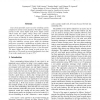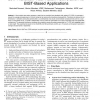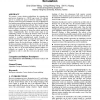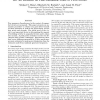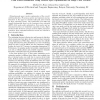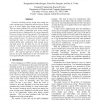HIPC
2009
Springer
14 years 27 days ago
2009
Springer
Recently proposed techniques for peak power management [18] involve centralized decisionmaking and assume quick evaluation of the various power management states. These techniques...
ETS
2009
IEEE
14 years 28 days ago
2009
IEEE
Scan circuit generally causes excessive switching activity compared to normal circuit operation. The higher switching activity in turn causes higher peak power supply current whic...
TC
2008
14 years 3 months ago
2008
A low-transition test pattern generator, called the low-transition linear feedback shift register (LT-LFSR), is proposed to reduce the average and peak power of a circuit during te...
FPL
2008
Springer
14 years 4 months ago
2008
Springer
Exploiting the underutilisation of variable-length DSP algorithms during normal operation is vital, when seeking to maximise the achievable functionality of an application within ...
GLVLSI
2007
IEEE
14 years 4 months ago
2007
IEEE
We present a vector selection methodology for estimating the peak power dissipation in a CMOS logic circuit. The ultimate goal is to combine the speed of RT-level simulation with ...
ISLPED
1997
ACM
14 years 6 months ago
1997
ACM
New measures of peak power in the context of sequential circuits are proposed. This paper presents an automatic procedure to obtain very good lower bounds on these measures as wel...
DAC
2004
ACM
14 years 6 months ago
2004
ACM
This paper presents a method of generating tests for transition faults using tests for stuck-at faults such that the peak power is the minimum possible using a given set of tests ...
DATE
1999
IEEE
14 years 7 months ago
1999
IEEE
Estimating peak power involves optimization of the circuit's switching function. We propose genetic spot expansion and optimization in this paper to estimate tight peak power...
VTS
2000
IEEE
14 years 7 months ago
2000
IEEE
Excessive switching activity during scan testing can cause average power dissipation and peak power during test to be much higher than during normal operation. This can cause prob...
VTS
2002
IEEE
14 years 8 months ago
2002
IEEE
This paper presents a procedure for modifying a given set of scan vectors so that the peak power during scan testing is kept below a specified limit without reducing fault coverag...

